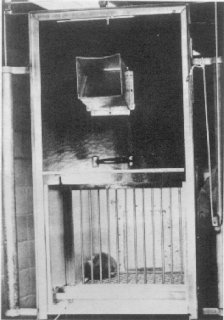Related Research Articles
Operant conditioning is a type of associative learning process through which the strength of a behavior is modified by reinforcement or punishment. It is also a procedure that is used to bring about such learning.

Primatology is the scientific study of primates. It is a diverse discipline at the boundary between mammalogy and anthropology, and researchers can be found in academic departments of anatomy, anthropology, biology, medicine, psychology, veterinary sciences and zoology, as well as in animal sanctuaries, biomedical research facilities, museums and zoos. Primatologists study both living and extinct primates in their natural habitats and in laboratories by conducting field studies and experiments in order to understand aspects of their evolution and behaviour.

An operant conditioning chamber is a laboratory apparatus used to study animal behavior. The operant conditioning chamber was created by B. F. Skinner while he was a graduate student at Harvard University. It may have been inspired by Jerzy Konorski's studies. It is used to study both operant conditioning and classical conditioning.
The experimental analysis of behavior is school of thought in psychology founded on B. F. Skinner's philosophy of radical behaviorism and defines the basic principles used in applied behavior analysis. A central principle was the inductive reasoning data-driven examination of functional relations, as opposed to the kinds of hypothetico-deductive learning theory that had grown up in the comparative psychology of the 1920–1950 period. Skinner's approach was characterized by observation of measurable behavior which could be predicted and controlled. It owed its early success to the effectiveness of Skinner's procedures of operant conditioning, both in the laboratory and in behavior therapy.

Animal cognition encompasses the mental capacities of non-human animals. The study of animal conditioning and learning used in this field was developed from comparative psychology. It has also been strongly influenced by research in ethology, behavioral ecology, and evolutionary psychology; the alternative name cognitive ethology is sometimes used. Many behaviors associated with the term animal intelligence are also subsumed within animal cognition.

Harry Frederick Harlow was an American psychologist best known for his maternal-separation, dependency needs, and social isolation experiments on rhesus monkeys, which manifested the importance of caregiving and companionship to social and cognitive development. He conducted most of his research at the University of Wisconsin–Madison, where humanistic psychologist Abraham Maslow worked with him for a short period of time.

The Silver Spring monkeys were 17 wild-born macaque monkeys from the Philippines who were kept in the Institute for Behavioral Research in Silver Spring, Maryland. From 1981 until 1991, they became what one writer called the most famous lab animals in history, as a result of a battle between animal researchers, animal advocates, politicians, and the courts over whether to use them in research or release them to a sanctuary. Within the scientific community, the monkeys became known for their use in experiments into neuroplasticity—the ability of the adult primate brain to reorganize itself.

The Pit of despair was a name used by American comparative psychologist Harry Harlow for a device he designed, technically called a vertical chamber apparatus, that he used in experiments on rhesus macaque monkeys at the University of Wisconsin–Madison in the 1970s. The aim of the research was to produce an animal model of depression. Researcher Stephen Suomi described the device as "little more than a stainless-steel trough with sides that sloped to a rounded bottom":
A 3⁄8 in. wire mesh floor 1 in. above the bottom of the chamber allowed waste material to drop through the drain and out of holes drilled in the stainless-steel. The chamber was equipped with a food box and a water-bottle holder, and was covered with a pyramid top [removed in the accompanying photograph], designed to discourage incarcerated subjects from hanging from the upper part of the chamber.

The Primate Freedom Project is a 501(c)(3) not-for-profit grassroots animal rights organization based in Atlanta, Georgia. It is dedicated to ending the use of nonhuman primates in biomedical and harmful behavioral experimentation.
Spatial view cells are neurons in primates' hippocampus; they respond when a certain part of the environment is in the animal's field of view.
Stephen J. Suomi is chief of the Laboratory of Comparative Ethology at the National Institute of Child Health and Human Development (NICHD) in Bethesda, Maryland. He is also a research professor at the University of Virginia, the University of Maryland, and Johns Hopkins University. He is involved with the Experience-based Brain & Biological Development Program, launched in 2003 by the Canadian Institute for Advanced Research.
Primate cognition is the study of the intellectual and behavioral skills of non-human primates, particularly in the fields of psychology, behavioral biology, primatology, and anthropology.

Conditioned place preference (CPP) is a form of Pavlovian conditioning used to measure the motivational effects of objects or experiences. By measuring the amount of time an animal spends in an area that has been associated with a stimulus, researchers can infer the animal's liking for the stimulus. This paradigm can also be used to measure conditioned place aversion with an identical procedure involving aversive stimuli instead. Both procedures usually involve mice or rats as subjects. This procedure can be used to measure extinction and reinstatement of the conditioned stimulus. Certain drugs are used in this paradigm to measure their reinforcing properties. Two different methods are used to choose the compartments to be conditioned, and these are biased vs. unbiased. The biased method allows the animal to explore the apparatus, and the compartment they least prefer is the one that the drug is administered in and the one they most prefer is the one where the vehicle is injected. This method allows the animal to choose the compartment they get the drug and vehicle in. In comparison, the unbiased method does not allow the animal to choose what compartment they get the drug and vehicle in and instead the researcher chooses the compartments.
Self-administration is, in its medical sense, the process of a subject administering a pharmacological substance to themself. A clinical example of this is the subcutaneous "self-injection" of insulin by a diabetic patient.
The study of memory incorporates research methodologies from neuropsychology, human development and animal testing using a wide range of species. The complex phenomenon of memory is explored by combining evidence from many areas of research. New technologies, experimental methods and animal experimentation have led to an increased understanding of the workings of memory.
Episodic-like memory is the memory system in animals that is comparable to human episodic memory. The term was first described by Clayton & Dickinson referring to an animal’s ability to encode and retrieve information about ‘what’ occurred during an episode, ‘where’ the episode took place, and ‘when’ the episode happened. This ability in animals is considered ‘episodic-like’ because there is currently no way of knowing whether or not this form of remembering is accompanied by conscious recollection—a key component of Endel Tulving’s original definition of episodic memory.
Developmental homeostasis is a process in which animals develop more or less normally, despite defective genes and deficient environments. It is an organisms ability to overcome certain circumstances in order to develop normally. This can be either a physical or mental circumstance that interferes with either a physical or mental trait. Many species have a specific norm, where those who fit that norm prosper while those who don't are killed or find it difficult to thrive. It is important that the animal be able to interact with the other group members effectively. Animals must learn their species' norms early to live a normal, successful life for that species.

Emil Wolfgang Menzel Jr. was a prominent primatologist and comparative psychologist. In many ways, his pioneering observations and research laid the foundation and set the precedent for many contemporary research topics in psychology and primatology including nonverbal and gestural communication, theory of mind and behavioral economics.
WGTA may refer to:
Association in psychology refers to a mental connection between concepts, events, or mental states that usually stems from specific experiences. Associations are seen throughout several schools of thought in psychology including behaviorism, associationism, psychoanalysis, social psychology, and structuralism. The idea stems from Plato and Aristotle, especially with regard to the succession of memories, and it was carried on by philosophers such as John Locke, David Hume, David Hartley, and James Mill. It finds its place in modern psychology in such areas as memory, learning, and the study of neural pathways.
References
- 1 2 3 Davenport, John W.; Chamove, Arnold S.; Harlow, Harry F. (1970). "The semiautomatic Wisconsin general test apparatus". Behavior Research Methods & Instrumentation. 2 (3): 135. doi: 10.3758/BF03211023 .
- 1 2 3 4 5 6 7 8 "Primate Lab History". University of Wisconsin, Madison. Retrieved September 21, 2014.
- 1 2 3 4 5 "WGTA Tests of Learning and Memory". Center on Human Development and Disability, Washington National Primate Research Center. Retrieved September 21, 2014.
- ↑ Colman, Andrew (2008). A Dictionary of Psychology (3 ed.). Oxford University Press. ISBN 9780199534067 . Retrieved September 21, 2014.
- 1 2 Roberts, Angela (2010). Encyclopedia of Psychopharmacology. Berlin: Springer. p. 1310. ISBN 9783540686989.
- 1 2 Wright, Dennis C.; French, Gilbert M.; Pinsker, Harold M. (1971). "A Semiautomated Wisconsin General Test Apparatus". Behavior Research Methods & Instrumentation. 3 (4): 189. doi: 10.3758/BF03208130 .
- 1 2 3 Walker, Stephen F. (1987). Animal Learning: An Introduction . London: Routledge & Kegan Paul. pp. 271–272.
- ↑ Rollin, A. Robert; Shepp, Bryan E.; Thaller, K.E. (1963). "A Modified Wisconsin General Test Apparatus for the Rat". American Journal of Psychology. 76 (3): 500–502. doi:10.2307/1419797. JSTOR 1419797.
- ↑ Purnelle, Mary B.; Rumbaugh, Duane M. (1965). "A modified Wisconsin General Test Apparatus for use with a variety of small primates". Perceptual and Motor Skills. 21 (2): 489–490. doi:10.2466/pms.1965.21.2.489. PMID 4954589. S2CID 28535113.
- ↑ Hunton, Vera D.; Hicks, Leslie H. (1959). "A portable modification of the Wisconsin general-test apparatus". The American Journal of Psychology. 72 (2): 291–292. doi:10.2307/1419382. JSTOR 1419382.
{{University of Wisconsin–Madison}}